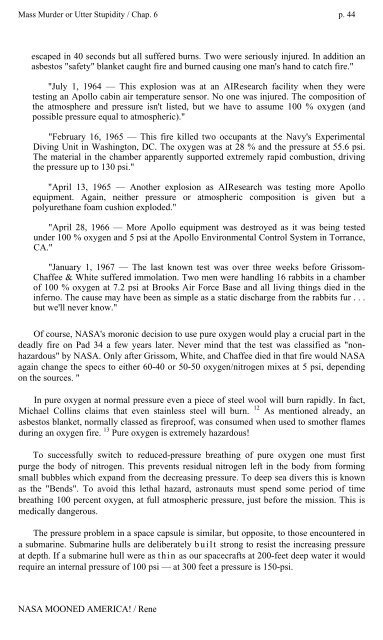Rene-NASA-Mooned-America
Rene-NASA-Mooned-America
Rene-NASA-Mooned-America
Create successful ePaper yourself
Turn your PDF publications into a flip-book with our unique Google optimized e-Paper software.
Mass Murder or Utter Stupidity / Chap. 6 p. 44<br />
escaped in 40 seconds but all suffered burns. Two were seriously injured. In addition an<br />
asbestos "safety" blanket caught fire and burned causing one man's hand to catch fire."<br />
"July 1, 1964 — This explosion was at an AIResearch facility when they were<br />
testing an Apollo cabin air temperature sensor. No one was injured. The composition of<br />
the atmosphere and pressure isn't listed, but we have to assume 100 % oxygen (and<br />
possible pressure equal to atmospheric)."<br />
"February 16, 1965 — This fire killed two occupants at the Navy's Experimental<br />
Diving Unit in Washington, DC. The oxygen was at 28 % and the pressure at 55.6 psi.<br />
The material in the chamber apparently supported extremely rapid combustion, driving<br />
the pressure up to 130 psi."<br />
"April 13, 1965 — Another explosion as AIResearch was testing more Apollo<br />
equipment. Again, neither pressure or atmospheric composition is given but a<br />
polyurethane foam cushion exploded."<br />
"April 28, 1966 — More Apollo equipment was destroyed as it was being tested<br />
under 100 % oxygen and 5 psi at the Apollo Environmental Control System in Torrance,<br />
CA."<br />
"January 1, 1967 — The last known test was over three weeks before Grissom-<br />
Chaffee & White suffered immolation. Two men were handling 16 rabbits in a chamber<br />
of 100 % oxygen at 7.2 psi at Brooks Air Force Base and all living things died in the<br />
inferno. The cause may have been as simple as a static discharge from the rabbits fur . . .<br />
but we'll never know."<br />
Of course, <strong>NASA</strong>'s moronic decision to use pure oxygen would play a crucial part in the<br />
deadly fire on Pad 34 a few years later. Never mind that the test was classified as "nonhazardous"<br />
by <strong>NASA</strong>. Only after Grissom, White, and Chaffee died in that fire would <strong>NASA</strong><br />
again change the specs to either 60-40 or 50-50 oxygen/nitrogen mixes at 5 psi, depending<br />
on the sources. "<br />
In pure oxygen at normal pressure even a piece of steel wool will burn rapidly. In fact,<br />
Michael Collins claims that even stainless steel will burn. 12 As mentioned already, an<br />
asbestos blanket, normally classed as fireproof, was consumed when used to smother flames<br />
during an oxygen fire. 13 Pure oxygen is extremely hazardous!<br />
To successfully switch to reduced-pressure breathing of pure oxygen one must first<br />
purge the body of nitrogen. This prevents residual nitrogen left in the body from forming<br />
small bubbles which expand from the decreasing pressure. To deep sea divers this is known<br />
as the "Bends". To avoid this lethal hazard, astronauts must spend some period of time<br />
breathing 100 percent oxygen, at full atmospheric pressure, just before the mission. This is<br />
medically dangerous.<br />
The pressure problem in a space capsule is similar, but opposite, to those encountered in<br />
a submarine. Submarine hulls are deliberately built strong to resist the increasing pressure<br />
at depth. If a submarine hull were as thin as our spacecrafts at 200-feet deep water it would<br />
require an internal pressure of 100 psi — at 300 feet a pressure is 150-psi.<br />
<strong>NASA</strong> MOONED AMERICA! / <strong>Rene</strong>


